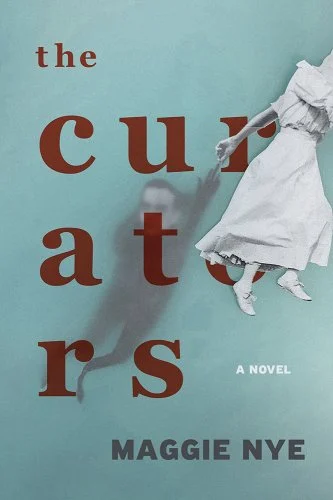
Section Branding
Header Content
In debut novel, Maggie Nye explores obsession, magic and a dark moment in Georgia history
Primary Content
LISTEN: A new novel set in Atlanta at the time of Leo Frank's lynching focuses on five adolescent girls who are obsessed with Frank. It's called "The Curators." GPB's Peter Biello speaks with author Maggie Nye.

In 1915, an Atlanta man named Leo Frank was murdered by a mob who believed he was responsible for the murder of a woman named Mary Phagan.
Antisemitism was at the root of the mob's fury. A new novel set in Atlanta at the time of the lynching and its aftermath focuses on five adolescent girls who are obsessed with Frank. It's called The Curators and its author, Maggie Nye, spoke with GPB’s Peter Biello.
TRANSCRIPT
Peter Biello: You based your novel on the true story of Leo Frank. And while the novel doesn’t go through each detail of his case, you do make some [details] known to your readers. What facets of the Leo Frank story did you really want your readers to know about so that they could fully understand what your main characters are obsessed with?
Maggie Nye: In 1913, a factory worker at the National Pencil Factor named Mary Phagan — she was one month shy of 14, so a 13-year-old laborer — was murdered in the basement of the National Pencil Factory. In the days and weeks following her murder, there were various suspects that the state and the police department investigated and the biggest names that emerged in that case were her Northern, Jewish superintendent Leo Frank and also a Black janitor named Jim Conley. Conley ended up being the state’s star witness. Her death was also complicated by a probable sexual assault. So the combination of a young, white, virginally-imagined laborer and this newly industrializing South stirred up a whole bunch of anxiety, especially in white men, and there was just this media frenzy focused on both Jim Conley’s Blackness and Leo Frank’s Jewishness. Eventually Frank was convicted of Mary Phagan's murder, and he was sentenced to death by hanging. His sentence was commuted by Gov. Slayton at the 11th hour, two days before he was sentenced to be hanged. He was taken to a Milledgeville, Ga., prison farm.
Peter Biello: The reason for the commutation is up for debate, but a mob was angry about it and hanged him in the name of Mary Phagan’s “honor.”
Maggie Nye: Yeah, and her honor is a sort of euphemism for virginity and white Southern womanhood and purity. It’s of utmost importance to her story. I’m actually very interested in Mary Phagan and her inscrutability because of the way she’s been mythologized as a figure of white Southern virginity. Even her headstone talks about how she was a martyr and died defending her “honor.”
Peter Biello: And what’s fascinating in your book is the group of five adolescent girls, 13-14 years old, they are obsessed with Leo and what the newspapers say about Leo. They don’t spend a whole lot of time thinking about Mary Phagan, even though you might imagine that they might identify with her, given their closeness in age.
Maggie Nye: I think that Leo is maybe a more appropriate avenue in the way that they’re imagining for this sort of nascent desire that they have. They do actually spend time thinking about Mary Phagan’s position as a working woman. They have this naive understanding or maybe fantasy that a working girl has access to this whole adult sexual world. So I think it’s a way for them to imagine themselves into a sexual life that is the more appropriate avenue for their desires.
Peter Biello: The girls in the book do something magical. They create a golem. One of your characters, Ana Wulff, spends a lot of time interacting with the golem. She spends time with him, keeps him in an attic closet. Tell us about the golem’s role in the story.
Maggie Nye: He’s not a traditional golem. He sort of has protective capacities but more than that he is the kind of product of their obsession and fantasy. So they construct this golem with the idea that he will look like Leo Frank, that they will produce a Leo Frank that can be in communication with them. And that through doing this they will have access to this absolute truth — and this is especially Ana’s fascination — that is denied to them. That they will know the true story.
Peter Biello: The stories Ana had heard about the golem in folklore is that they eat, they grow, they become almost independent by themselves, and they do what you that you would want them to do, almost magically. And she finds that she’s unprepared to deal with what is essentially a tiny little monster made out of dirt who can’t really do a whole lot.
Maggie Nye: Yes, they all have great hopes for this golem, that he will be the ticket to their ascendency into knowledge and understanding and to perhaps sexuality. But he’s really quite limited. He can do things like say the word “Nabisco” because eats a Nabisco wafer cookie. Ana, I think, sees the potential for him to be something more. She really does believe that somewhere in the core of him there is a capital “T” Truth. There is absolute knowledge that she can inhabit and do the right thing. Because by the time we get to this point in the story, they’ve done a lot of the wrong thing.
Peter Biello: The story certainly shifts when the golem appears. For me as a reader, my attention was focused on: "Oh no, they have created something they don’t fully understand." What’s going to happen with this thing? I’d be remiss if I gave it away in this interview. But it’s a fascinating part of the story and I appreciate you writing it.
Maggie Nye: Thank you so much.


